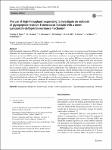The use of high-throughput sequencing to investigate an outbreak of glycopeptide-resistant Enterococcus faecium with a novel quinupristin-dalfopristin resistance mechanism
Shaw, Timothy D.
Fairley, D. J.
Schneiders, T.
Pathiraja, M.
Hill, R. L. R.
Werner, Guido
Elborn, J. S.
McMullan, R.
High-throughput sequencing (HTS) has successfully identified novel resistance genes in enterococci and determined clonal relatedness in outbreak analysis. We report the use of HTS to investigate two concurrent outbreaks of glycopeptide-resistant Enterococcus faecium (GRE) with an uncharacterised resistance mechanism to quinupristin-dalfopristin (QD). Seven QD-resistant and five QD-susceptible GRE isolates from a two-centre outbreak were studied. HTS was performed to identify genes or predicted proteins that were associated with the QD-resistant phenotype. MLST and SNP typing on HTS data was used to determine clonal relatedness. Comparative genomic analysis confirmed this GRE outbreak involved two distinct clones (ST80 and ST192). HTS confirmed the absence of known QD resistance genes, suggesting a novel mechanism was conferring resistance. Genomic analysis identified two significant genetic determinants with explanatory power for the high level of QD resistance in the ST80 QD-resistant clone: an additional 56aa leader sequence at the N-terminus of the lsaE gene and a transposon containing seven genes encoding proteins with possible drug or drug-target modification activities. However, HTS was unable to conclusively determine the QD resistance mechanism and did not reveal any genetic basis for QD resistance in the ST192 clone. This study highlights the usefulness of HTS in deciphering the degree of relatedness in two concurrent GRE outbreaks. Although HTS was able to reveal some genetic candidates for uncharacterised QD resistance, this study demonstrates the limitations of HTS as a tool for identifying putative determinants of resistance to QD.
Dateien zu dieser Publikation

